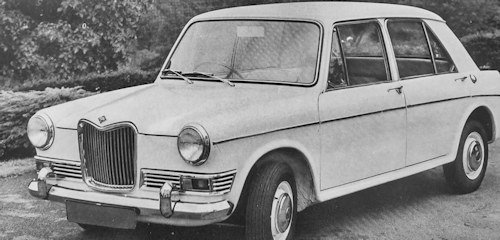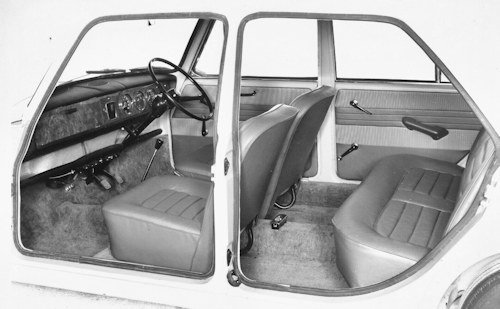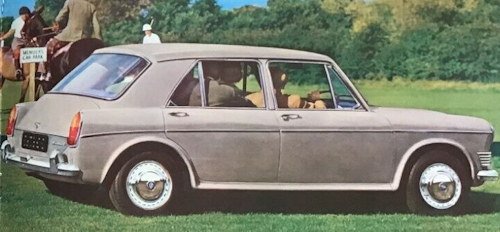Riley Kestrel
 |
|
|
Manufacturer |
British Motor Corporation |
|
Production |
1965 to 1969 |
|
Designer |
Sir Alec Issigonis, body Pininfarina |
|
Class |
Motor Car |
|
Body style |
saloon |
|
Layout |
Front engine, front-wheel drive |
|
Engine |
1.1 L A-Series I4 (1100) 1.3 L A-Series I4 (1300) |
|
Wheelbase |
93.5 in (2,375 mm) |
|
Length |
146.65 in (3,725 mm) |
|
Width |
60.38 in (1,534 mm) |
|
Height |
53 in (1,346 mm) |
|
Kerb weight |
1,834 lb (832 kg) approx. |
The Riley Kestrel was a British motor car from the 1960s, based on the BMC ADO16 range and was built from 1965 to 1969.
History
By September 1965 United Kingdom introduction of the Riley Kestrel four-door saloon the Riley Kestrel had three round dials including a rev counter in a wooden fascia offered with leather seats as standard. The BMC ADO16 was a range of small cars built by the British Motor Corporation (BMC) and, later, British Leyland. The Riley was first launched in 1965 two years after the original launch of the Austin versions as the Kestrel, Kestrel 1275 and also later just as the Riley 1100 and 1300 with out the Kestrel name. It was later discontinued in 1974.
The Riley Kestrel based on the ADO16 design by Alec Issigonis.Now a larger and more sophisticated car than the previous Riley Mini version which incorporated more advanced features and innovations. But still with the BMC A-Series engine, mounted transversely and driving the front wheels. The gearbox located under the engine, which also shared the oil supply with the engine. As well as disc brakes at the front. With an option for a four-speed automatic transmission.
PERFORMANCE: 1100
- Engine Capacity 67 cu in, 1,098 cu cm
- Fuel Consumption 35.3 m/imp gal, 29.4 m/US gal, 8 1 x 100 km
- Max Speed 88 mph, 141.7 km/h
- max power (SAE): 59 hp at 5,500 rpm
- max torque (DIN): 61 1b ft, 8.4 kg m at 2,750 rpm
- max engine rpm: 6,400; specific power: 53.7 hp/l
- power-weight ratio: 31.3 lb/hp, 14.2 kg/hp
- acceleration: standing 1/4-mile 21.5 sec, 0—50 mph (0—80) km/h 13.1 sec
PERFORMANCE: 1300
- Engine capacity:77.80 cu in, 1,275 cu cm
- Fuel consumption: 34 mlimp gal, 28.3 m/US gal, 8.3 1 x 100 km
- Max speed: 87 mph, 140 km/h
- max power (DIN): 58 hp at 5,250 rpm
- max torque (DIN): 69 1b ft, 9.5 kg m at 3,500 rpm
- max engine rpm: 5,900
- specific power: 45.5 hp/l
- power-weight ratio: 32 lb/hp, 14.5 kg/hp
- acceleration: 0—50 mph (0—80) km/h 11.4 sec
The Four-door saloon of mono-construction, rubber-mounted to front and rear sub-frame assemblies to give insulation between road wheels and body, the distribution of weight is 62% to the front axle and 38% to rear axle. Full-width bumpers with over-riders front and rear. External, rotary, ratchet-type locks on both front doors, front and rear doors lock from inside with children's safety catches fitted to all doors. Large panniers in front doors. Wind-up windows on doors with hinged quarter-lights on front doors. Curved safety glass windscreen with curved back-light and sidelights.

Inside features Veneered, figured-walnut fascia with ashtray and also central ashtray for rear compartment. Two crushable sun visors. Interior, safety, rear-view mirror. Adjustable front seats, and all wearing surfaces upholstered in real leather. Fitted carpets on floor. Luggage boot at rear of car fitted with locking spring-assisted lid the boot (trunk)capacity of 9 cu. ft. Bonnet lock cable-operated from inside car, separate safety catch bonnet held open by telescopic prop. Anchorage points for seat belts at front. Provision for radio. Speedometer with total mileage recorder; Oil pressure, water temperature, and fuel gauges with revolution Counter; ignition/starter switch; mixture control; lighting switch windscreen washer, windscreen Wiper switch; fresh-air heater demister unit.
At the end of May 1967, BMC announced the fitting of a larger 1275 cc engine to the Riley Kestrel. The 1275 cc engine became an optional extra on the Riley version, in single carburettor 58 bhp (43 kW) form. The new car combined the 1275 cc engine block already in the sporty Mini Cooper S and Austin-Healey Sprite models. October 1967 Launch of the 1100 Mark II models, with cropped rear fins, ventilated wheels, indicator side repeater lamps fitted to the front wings. A revised interior was also fitted. The Riley continued in four-door as the Riley Kestrel four-door 1100 or 1300.
PERFORMANCE 1300 Mark II
- Engine capacity: 77.80 cu in, 1,275 cu cm
Fuel consumption: 32.5 m/imp gal, 27 m/US gal, 8.7 1 x 100 km - Max speed: 97 mph, 156.2 km/h
- max power (DIN): 70 hp at 6,000 rpm
- max torque (DIN): 77 1b ft, 10.7 kg m at 3,000 rpm
- max engine rpm: 6,000
- specific power: 54.9 hp/l
- power-weight ratio 23.6 lb/hp, 10.7 kg/hp
- acceleration: standing 1/4 mile 19.6 sec, 0—50 mph (0 —80 km/h) 9.4 sec

January 1968 United Kingdom: British Leyland (BL) takes over British Motor Holdings Limited. British Leyland starts to cull the range, first model to be discontinued is the Riley Kestrel 1100.By April 1968 United Kingdom Riley Kestrel 1300 four-door with twin SU 65 bhp engine introduced replacing single 56 bhp engine. June 1968 a more powerful twin carburettor version of BMC's 1,275 cc engine is fitted to manual gearbox versions of the Riley, automatic transmission versions retained the single carburettor engine. The Mark II versions of the Riley, were introduced in October 1968, at which time Riley abandoned the Kestrel name October 1968. The Kestrel name is dropped from the Riley model and it is now named Riley 1300 Mk. II. The Riley models are updated with a new interior, which includes rocker switches fitted instead of toggle switches and a central armrest in the rear seat.
The Riley 1300 Mark II was discontinued in July 1969, and signalled the final demise of the Riley marque along with the Riley name.
OPTIONAL EXTRAS: Laminated-glass windscreen; Dunlop Whitewall and Weather master Tyres; reclining front seats; electrically heated rear window. Automatic transmission. Available through Distributor or Dealer: Wing mirrors; seat belts; roof racks; auxiliary lamps; seat covers; car-valeting items; locking petrol cap; anti-mist panels; touch-up paints; hand tools; fire extinguisher; exhaust trim; badge bar.

Technical
-
Riley Kestrel Technical details and specifications (1965-1969)
ENGINE: 1100
front, 4 stroke, transverse
cylinders: 4, vertical, in line
bore and stroke: 2.54 x 3.29 in, 64.6 x 83.7 mm
engine capacity: 67 cu in, 1,098 cu cm
compression ratio: 8.9
cylinder block: cast iron
cylinder head: cast iron
crankshaft bearings: 3
valves: 2 per cylinder, overhead, in line, push-rods and rockers
camshafts: 1, side
lubrication: eccentric pump, full flow filter
lubricating system capacity: 8.80 imp pt, 10.57 US pt, 5 1
carburation: 2 SU type HS 2 semi-downdraught carburettors
fuel feed: electric pump
cooling system: waterENGINE: 1300
4 stroke, transverse; cylinders: 4, vertical, in line
bore and stroke: 2.78 x 3.20 in, 70.6 x 81.3 mm
engine capacity: 77.80 cu in, 1,275 cu cm
compression ratio: 8.8 Mark II 9.7
cylinder block: cast iron
cylinder head: cast iron
crankshaft bearings: 3
valves: 2 per cylinder, overhead, in line, push-rods and rockers
camshafts: 1, side
lubrication: gear or vane-type pump, full flow filter
carburation: 1 SU type HS 2 semi-downdraught carburettor, Mark II 2 SU type HS.
fuel feed: electric pump
cooling system: waterTRANSMISSION
driving wheels: front
clutch: single dry plate, hydraulically controlled
gearbox: mechanical; gears: 4 + reverse
synchromesh gears: 2nd, 4th
gearbox ratios: 1st 3.627, 2nd 2.172, 3rd 1.412, 4th 1, rev 3.627
final drive: helical spur gears; axle ratio: 4.133.CHASSIS
type integral with front and rear auxiliary frames
front suspension: independent, wishbones, hydrolastic (liquid) rubber cone springs, hydraulic connecting pipes to rear wheels
rear suspension: independent, swinging longitudinal trailing arms, hydrolastic (liquid) rubber cone springs, hydraulic connecting pipes to front wheels, combined with transverse torsion bars, anti-roll bar.STEERING
rack-and-pinion
turns of steering wheel lock to lock: 3.
turning circle (between walls): 34 ft, 10.4 mBRAKES
front disc (diameter 8 in, 203 mm)
rear drum; area rubbed by linings: total 196.20 sq in, 1,265.49 sq cm.ELECTRICAL EQUIPMENT
voltage: 12 V
battery: 43 Ah
generator type: dynamo, 264 W
ignition distributor: Lucas Automatic advance and retard With centrifugal and vacuum control.
rear-mounted S.C. electric fuel pump
double-dipping sealed-beam headlamps
parking lights
twin stoptail lamps; rear reflectors
number-plate lamps
flashing direction indicators with repeater flashers on wings
single lever on steering-column combines horn, headlamp flasher, dip switch, and self-cancelling direction flashers
instrument and parcel shelf lamps
dual-arm windscreen Wipers
twin electric horns
interior roof light With courtesy switch
warning lights for ignition, headlight main beam, oil pressure, , and direction indicators.DIMENSIONS AND WEIGHT
wheel base: 93.50 in, 2,375 mm
front track: 51.50 in, 1,308 mm
rear track: 50.87 in, 1,292 mm
overall length: 146.75 in, 3,727 mm
overall width: 60.37 in, 1,533 mm
overall height: 53 in, 1,346 mm
ground clearance: 6 in, 152 mm
dry weight: 1,852 1b, 840 kg© Motor car History
Service
-
Riley Kestrel maintenance and Service Guide (1965-1969)
Greasing: every 3,000 miles, 4,800 km, 4 points
Normal tyre pressure: front 28 psi, 2 atm, rear 24 psi, 1.7 atm.
Tyres: 5.50 x 12 tubeless
Wheels: ventilated disc-type 4J x 12 in. wheels with four-studs
Fuel tank capacity: 8.5 imp gal, 10.3 US gal, 39 1.
Carrying capacity: 882 1b, 400 kg
Spare Wheel: housed in luggage compartment1100
fuel: 98-100 oct petrol
engine oil, gearbox and final drive oil: 6.70 imp pt, 8.03 US pt, 3.8 1, SAE 1OW-30, change every 6,000 miles, 9,700 km
air filter: Paper element air cleaner With silencer.
Fuel Filters contained in fuel tank and fuel pump. Tank is fitted under luggage boot
cooling system capacity: 6.80 imp pt, 8.24 US pt, 3.9 1
tappet clearances: inlet 0.012 in, 0.30 mm, exhaust 0.012 in, 0.30 mm
valve timing: inlet opens 5° before tdc and closes 45° after bdc, exhaust opens 51° before bdc and closes 21° after tdc1300
fuel: 98-100 oct petrol
engine sump, gearbox and final drive oil: 7.50 imp pt, 9.09 US pt, 4.3 1, SAE 10W-30, change every 6,000 miles, 9,700 km
Total lubricating system capacity: 9 imp pt, 10.78 US pt
cooling system capacity: 6.80 imp pt, 8.24 US pt
tappet clearances: inlet 0.012 in, 0.30 mm, exhaust 0.012 in, 0.30 mm
valve timing: inlet opens 5° before tdc and closes 45° after bdc, exhaust opens 51° before bdc and closes 21° after tdc© Motor car History
